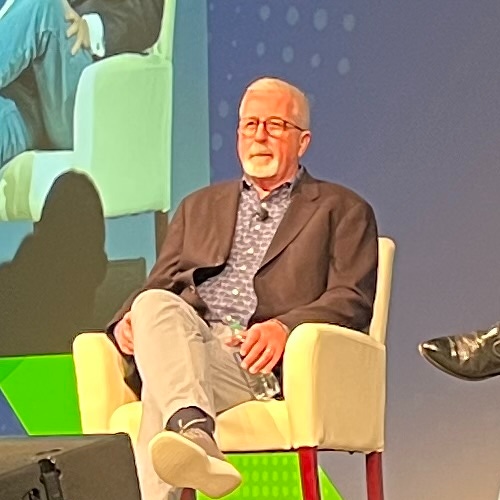
DENVER – Dish Network's Dave Mayo made one major request during a keynote appearance at the Wireless Infrastructure Association's Connect (X) trade show here this week: To get better information about the condition of the hundreds of thousands of cell towers scattered around the US.
His request is noteworthy because the WIA trade association primarily represents the nation's biggest cell tower owners, and because Dish is in the process of building a brand new nationwide 5G network. However, according to Mayo, the company has had to conduct its own cell tower assessments to see whether there is the space and the structural capacity for its radios.
The fact that Dish has to go out and get that information "seems backwards," said Mayo, who is the Dish executive in charge of the construction of the company's 5G network. "It would go much more smoothly" if the cell tower owners themselves could provide that information to Dish, he said.
Figure 1:  Mayo, left, speaks with Rob McDowell, of law firm Cooley, during a keynote session at the Connect (X) trade show.
Mayo, left, speaks with Rob McDowell, of law firm Cooley, during a keynote session at the Connect (X) trade show.
(Source: Mike Dano, Light Reading)
Mayo isn't the only executive in the wireless industry talking about the issue. In a recent discussion with Light Reading on the topic, Sitetracker's Brant Carter said there's a push within the industry to create "digital twins" cell towers – exact digital 3D replicas of the real-world structures that companies can then use to make assessments. Sitetracker operates a database of cell site locations that tower companies like Tillman Infrastructure use to manage new site builds, tower modifications and upgrades.
Carter said digital twins can allow prospective cell tower customers – like Dish – to evaluate the space and structural capabilities of a given tower without needing to check it out in person. After all, cell tower owners like Crown Castle and American Tower rent out space on their cell towers – often by the foot – to network operators like Dish, AT&T and T-Mobile.
Dish's Mayo said the company has already invested heavily into the "digital twin" concept. During Dish's recent analyst event, Mayo said the company has used drones to create digital twins of the towers it's using in order to see whether the structures can meet the company's 5G coverage objectives. For example, knowing the exact height of a tower can allow a network operator to determine how far its radios can broadcast a 5G signal.
To be clear, there are a wide range of factors that go into cell tower calculations. Other issues include whether the tower can support the weight of an operator's radios, whether wind and weather will affect the tower's structural integrity, and whether the materials used to build the tower have aged over time.
But Sitetracker's Carter said digital twins are a relatively new phenomena in the cell tower industry. He said Sitetracker's systems can handle digital twin information, but that few tower companies have invested into the technology. Part of the problem, he said, is that there's no standard format for digital twin information, making it difficult for a tower company to share its digital twin with a prospective customer. Another issue: Creating a digital twin of a tower site involves a lot of raw data, and storing and moving that data can be challenging.
"Interest is what we're hearing," Carter said of digital twins. But he said there's been very little firm movement toward the technology.
Related posts:
— Mike Dano, Editorial Director, 5G & Mobile Strategies, Light Reading | @mikeddano
About the Author(s)
You May Also Like











